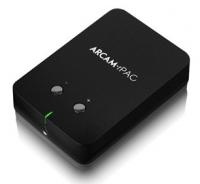The built-in speakers on Macs are serviceable but certainly don’t provide audiophile-pleasing sound. If you want to enhance your Mac’s audio, the US$249.99 Arcam rPAC (http://macte.ch/28EZW) offers an excellent way to do so.
It’s an USB, bus-powered DAC and headphone amplifier designed to improve the audio performance of both Apple and Windows computers. Compact enough to be transportable — and it comes with a carrying case — the Arcam rPAC provides high-end sound via its use of a digital-to-analogue converter (DAC).
It boasts a minimalist design. The only buttons are for volume. One button is for raising the volume, the other is for lowering it. Press both together and you mute the audio.
According to the folks at Arcam, the rPAC takes the signal from the computer via USB, re-clocks and de-jitters the signal, then delivers it through a low noise output stage directly to your computer’s amp analogue input or via its own headphone amplifier. The rPAC also sports enhanced RF suppression for noisy digital environments. In other words, it can boost all your computer audio — from music to gaming to movies.
When it comes to specs, the rPAC has a maximum sample rate of 96kHz and a bit depth of up to 24-bit — though, like me, you’ll probably spend most of your time playing audio files recorded at 44.1kHz and 16-bit (the specification of the CD audio standard). The device has a frequency response of 10Hz to 20,000Hz and a signal-to-noise ratio (SNR) of 106dB (the dedicated headphone amp has an SNR of 98dB).
It’s easy to set up. Just connect the rPAC to your Mac with the supplied USB cable, then either onto an audio system via a standard RCA lead (also included), or out to headphones. No batteries or mains are necessary. However, if you need to connect to regular speakers that lack RCA inputs, you’ll need an RCA-to-minijack converter. Also, since the device is USB powered, the volume level is a bit limited — though you won’t notice unless you plan on literally raising the roof.
One of the nice features of the rPAC is its rubberized base, which does a reasonably good job of preventing slippage. Although not heavy, it has enough heft (300g) that is won’t slid around helter skelter on a desktop.
We tested the rPAC with Shure and Sennheiser headphones and Bose and Audioengine speakers. In all cases the sound quality was definitely enhanced. We tested it with DVDs, CDs, music (country, rock and classical) and movies bought at iTunes, and games — and all sounded better than ever on our iMac. Sound was clean, warm and detailed.
What the rPAC doesn’t do is provide surround sound (that’s not it’s job). Nor can it overcome the inherent limitations of cheap headphones or speakers. If you’re going to spring for the DAC, you’ll need to own — or budget for — high-end speakers and headphones — and rip your music/videos at the highest quality possible.
Rating: 9 out of 10

